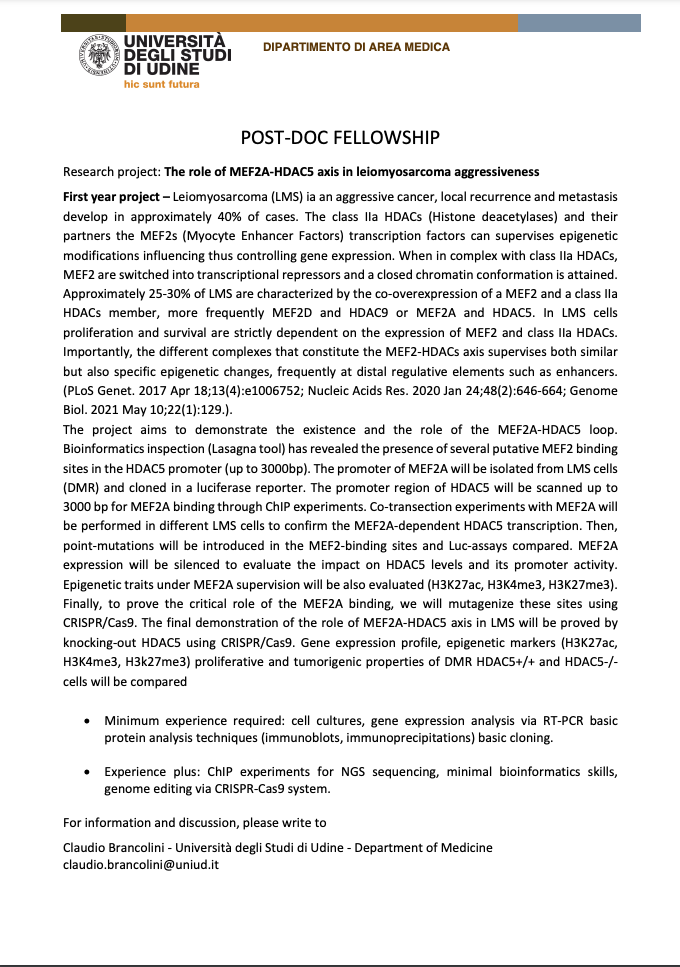POST-DOC FELLOWSHIP
The role of MEF2A-HDAC5 axis in leiomyosarcoma aggressiveness – University of Udine
First year project – Leiomyosarcoma (LMS) ia an aggressive cancer, local recurrence and metastasis develop in approximately 40% of cases. The class IIa HDACs (Histone deacetylases) and their partners the MEF2s (Myocyte Enhancer Factors) transcription factors can supervises epigenetic modifications influencing thus controlling gene expression. When in complex with class IIa HDACs, MEF2 are switched into transcriptional repressors and a closed chromatin conformation is attained.
Approximately 25-30% of LMS are characterized by the co-overexpression of a MEF2 and a class IIa HDACs member, more frequently MEF2D and HDAC9 or MEF2A and HDAC5. In LMS cells proliferation and survival are strictly dependent on the expression of MEF2 and class IIa HDACs.
Importantly, the different complexes that constitute the MEF2-HDACs axis supervises both similar but also specific epigenetic changes, frequently at distal regulative elements such as enhancers.
(PLoS Genet. 2017 Apr 18;13(4):e1006752; Nucleic Acids Res. 2020 Jan 24;48(2):646-664; Genome Biol. 2021 May 10;22(1):129.).
The project aims to demonstrate the existence and the role of the MEF2A-HDAC5 loop.
Bioinformatics inspection (Lasagna tool) has revealed the presence of several putative MEF2 binding sites in the HDAC5 promoter (up to 3000bp). The promoter of MEF2A will be isolated from LMS cells (DMR) and cloned in a luciferase reporter. The promoter region of HDAC5 will be scanned up to 3000 bp for MEF2A binding through ChIP experiments. Co-transection experiments with MEF2A will be performed in different LMS cells to confirm the MEF2A-dependent HDAC5 transcription. Then, point-mutations will be introduced in the MEF2-binding sites and Luc-assays compared. MEF2A expression will be silenced to evaluate the impact on HDAC5 levels and its promoter activity.
Epigenetic traits under MEF2A supervision will be also evaluated (H3K27ac, H3K4me3, H3K27me3).
Finally, to prove the critical role of the MEF2A binding, we will mutagenize these sites using CRISPR/Cas9. The final demonstration of the role of MEF2A-HDAC5 axis in LMS will be proved by knocking-out HDAC5 using CRISPR/Cas9. Gene expression profile, epigenetic markers (H3K27ac, H3K4me3, H3k27me3) proliferative and tumorigenic properties of DMR HDAC5+/+ and HDAC5-/- cells will be compared
- Minimum experience required: cell cultures, gene expression analysis via RT-PCR basic protein analysis techniques (immunoblots, immunoprecipitations) basic cloning.
- Experience plus: ChIP experiments for NGS sequencing, minimal bioinformatics skills, genome editing via CRISPR-Cas9 system.
Contact information
For information and discussion, please write to: Claudio Brancolini – Università degli Studi di Udine – Department of Medicine
claudio.brancolini@uniud.it


